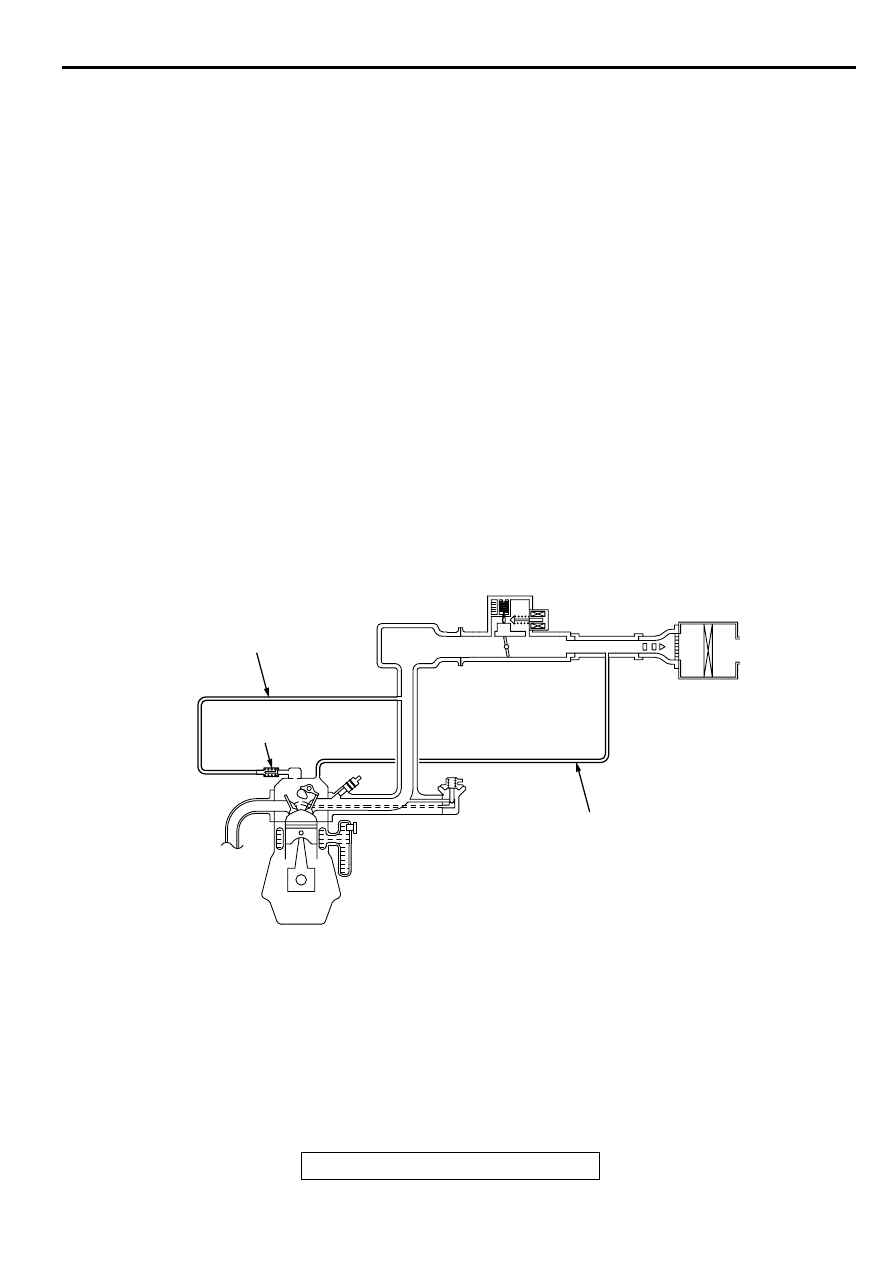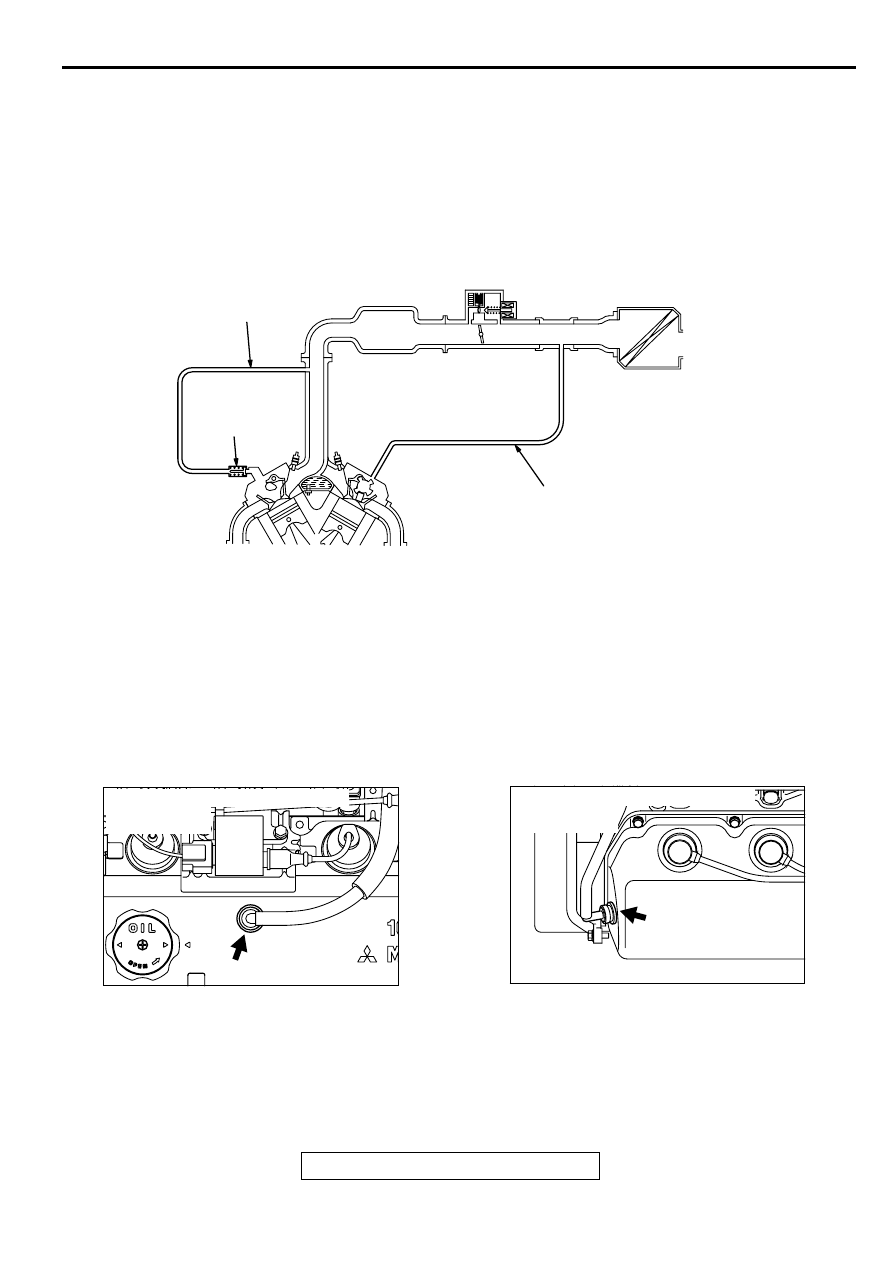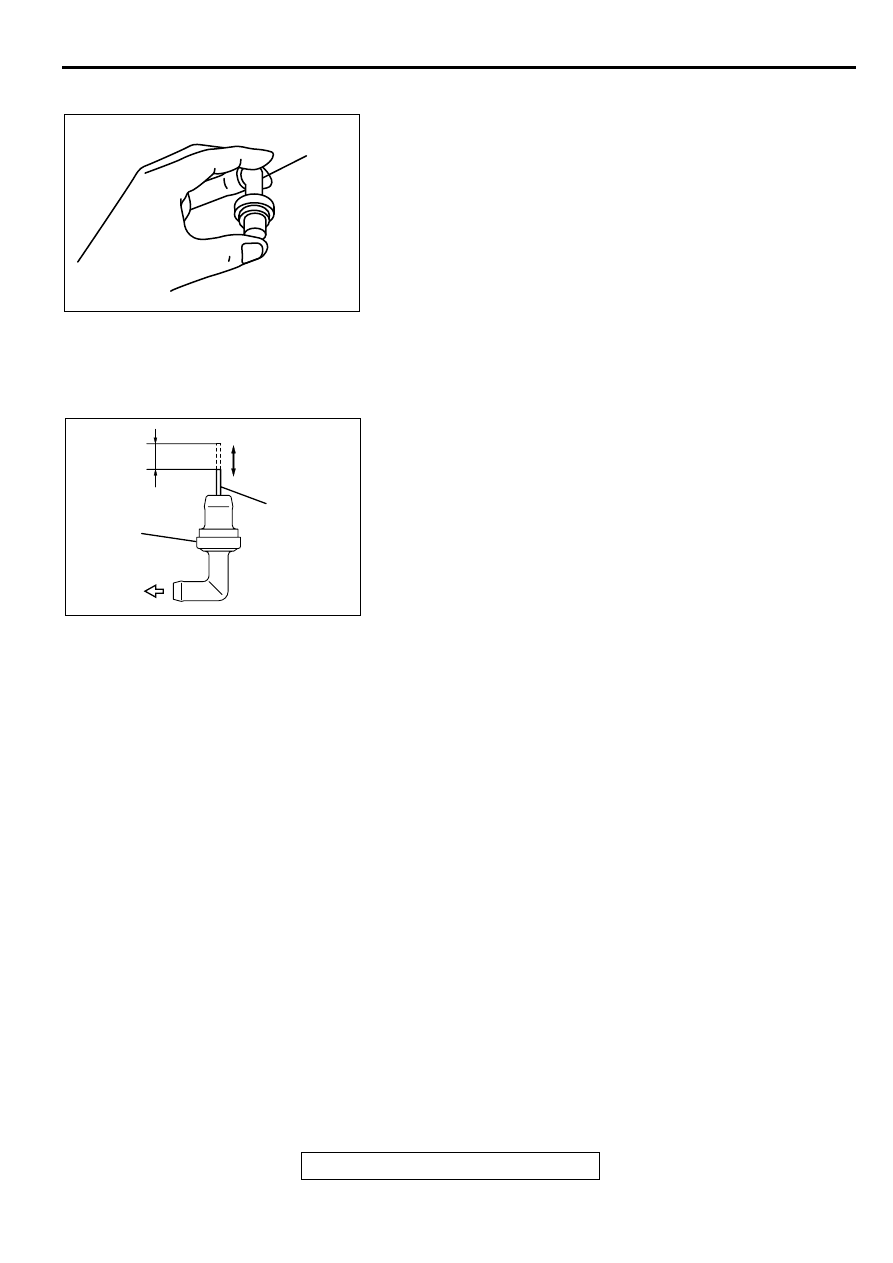Mitsubishi Eclipse / Eclipse Spyder (2000-2002). Service and repair manual — part 392

EMISSION CONTROL
TSB Revision
ENGINE AND EMISSION CONTROL
17-87
<3.0L ENGINE>
VACUUM HOSE INSTALLATION
M1173007200022
1. When connecting the vacuum hoses, they should be
securely inserted onto the nipples.
2. Connect the hoses correctly, using the VACUUM HOSE
ROUTING as a guide.
AKX01296
INTAKE MANIFOLD
THROTTLE BODY
TO COMB-
USTION
CHAMBER
FROM AIR
CLEANER
HOSE JOINT
EGR SOLENOID
(ON: CLOSE)
FUEL
PRESSURE
REGULATOR
EVAPORATIVE
EMISSION
PURGE
SOLENOID
(ON: OPEN)
CHAMBER
VACUUM
CONTROL
VALVE
EGR VALVE
FUEL
TANK
B: BLACK
G: GREEN
L: LIGHT BLUE
W: WHITE
Y: YELLOW
*1:RED PAINT MARK
*2:RESTRICTOR
EVAPORATIVE
EMISSION
CANISTER
EVAPORATIVE EMISSION
VENTILATION SOLENOID
(ON: CLOSE)
AB
B
B
B
B
B
B
B
B
B
B
L
G
G
G
Y
Y
W
*1
*1
*2

EMISSION CONTROL
TSB Revision
ENGINE AND EMISSION CONTROL
17-88
VACUUM HOSE CHECK
M1173007300029
1. Using the VACUUM HOSE ROUTING as a guide, check that
the vacuum hoses are correctly connected.
2. Check the connection of the vacuum hoses, (removed,
loose, etc.) and confirm that there are no sharp bends or
damage.
POSITIVE CRANKCASE VENTILATION SYSTEM
GENERAL DESCRIPTION (POSITIVE CRANKCASE VENTILATION SYSTEM)
M1173005000044
The positive crankcase ventilation system is a
system for preventing the escape of blow-by gases
from inside the crankcase into the atmosphere.
Fresh air is sent from the air cleaner into the
crankcase through the breather hose to be mixed
with the blow-by gas inside the crankcase.
The blow-by gas inside the crankcase is drawn into
the intake manifold through the positive crankcase
ventilation (PCV) valve.
The PCV valve is designed to lift the plunger
according to the intake manifold vacuum so as to
regulate the flow of blow-by gas properly.
In other words, the blow-by gas flow is regulated
during low load engine operation to maintain engine
stability, while the flow is increased during high load
operation to improve the ventilation performance.
SYSTEM DIAGRAM
<2.4L ENGINE>
AKX01297
VENTILATION HOSE
POSITIVE CRANKCASE
VENTILATION (PCV)
VALVE
BREATHER HOSE
AB

EMISSION CONTROL
TSB Revision
ENGINE AND EMISSION CONTROL
17-89
<3.0L ENGINE>
COMPONENT LOCATION
M1173007400026
AKX00334
BREATHER HOSE
VENTILATION HOSE
PCV VALVE
AB
AKX01299 AB
POSITIVE CRANKCASE VENTILATION
(PCV) VALVE
<2.4L ENGINE>
AKX01300AB
POSITIVE CRANKCASE VENTILATION
(PCV) VALVE
<3.0L ENGINE>

EMISSION CONTROL
TSB Revision
ENGINE AND EMISSION CONTROL
17-90
CRANKCASE VENTILATION SYSTEM CHECK
M1173001100049
1. Remove the positive crankcase ventilation (PCV) valve from
the rocker cover, then reconnect the PCV valve to the
vacuum supply hose.
2. With the engine idling, put your finger on the open end of the
PCV valve, and check for negative pressure (vacuum).
NOTE: At this time, the plunger in the PCV valve should
move back and forth as the open end is covered and
uncovered.
3. If negative pressure is not felt, clean or replace the PCV
valve. Inspect he vacuum supply hose and vacuum supply
hose port for restriction or plugged condition.
POSITIVE CRANKCASE VENTILATION (PCV)
VALVE CHECK
M1173001200046
1. Hold the PCV valve with the vacuum side down. Insert a thin
rod, and using light pressure, depress the end of the PCV
valve spring by 5
−
10 mm (0.2
−
0.3 inch). Release
pressure on the rod to see if the PCV valve spring will lift the
rod to its original position.
2. If the rod returns quickly to its original position, the PCV
valve is OK. If the stick does not return quickly. clean or
replace the PCV valve.
EVAPORATIVE EMISSION CONTROL SYSTEM
GENERAL DESCRIPTION
M1173005100041
The evaporative emission control system prevents
fuel vapors generated in the fuel tank from escaping
into the atmosphere.
Fuel vapors from the fuel tank flow through the vapor
pipe/hose to be stored temporarily in the evaporative
emission (EVAP) canister.
When the vehicle is in operation, fuel vapors stored
in the EVAP canister flow through the chamber, the
EVAP purge solenoid, purge port and intake manifold
plenum to the combustion chamber.
When the engine coolant temperature is low or when
the intake air quantity is small (when the engine is at
idle, for example), the engine control module brings
the EVAP purge solenoid into the OFF state to shut
off the fuel vapor flow to the intake manifold plenum.
This ensures driveability when the engine is cold or
running under low load and also stabilizes the
emission level.
An EVAP ventilation solenoid is provided between
the EVAP canister and atmosphere to monitor for
OBD-II EVAP leaks. This solenoid is normally OFF.
However, it turns ON when monitoring the OBD-II
EVAP leaks and shuts off the atmosphere flow to the
EVAP canister. Then the fuel tank differential
pressure sensor monitors the fuel vapor pressure to
detect OBD-II EVAP leaks. The fuel vent valve and
the leveling valve prevent fuel from being overfilled.
The fuel vent valve and the leveling valve prevents
fuel leaks just if the vehicle is rolled over in an
accident.
The vent valve releases the air from the fuel tank
through the evaporative emission canister into the
atmosphere when the fuel tank pressure increases
due to refueling, etc. The vent valve and the air filter
supply the atmospheric air to the evaporative
emission canister when the fuel tank pressure
decreases.
AKX00336
PCV VALVE
AB
AKX00337
5 - 10 mm
(0.2 - 0.3 in)
PCV VALVE
VACUUM SIDE
THIN ROD
(VERY
SMOOTH)
AB

Нет комментариевНе стесняйтесь поделиться с нами вашим ценным мнением.
Текст